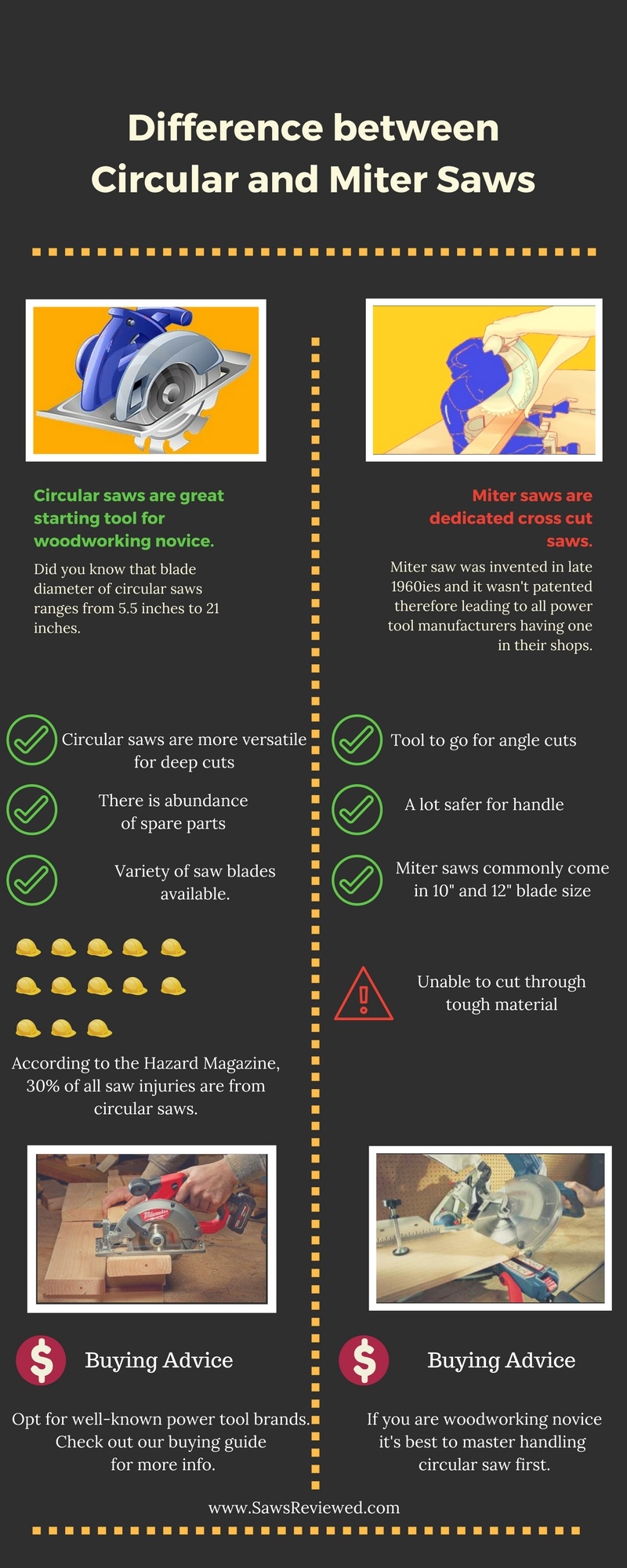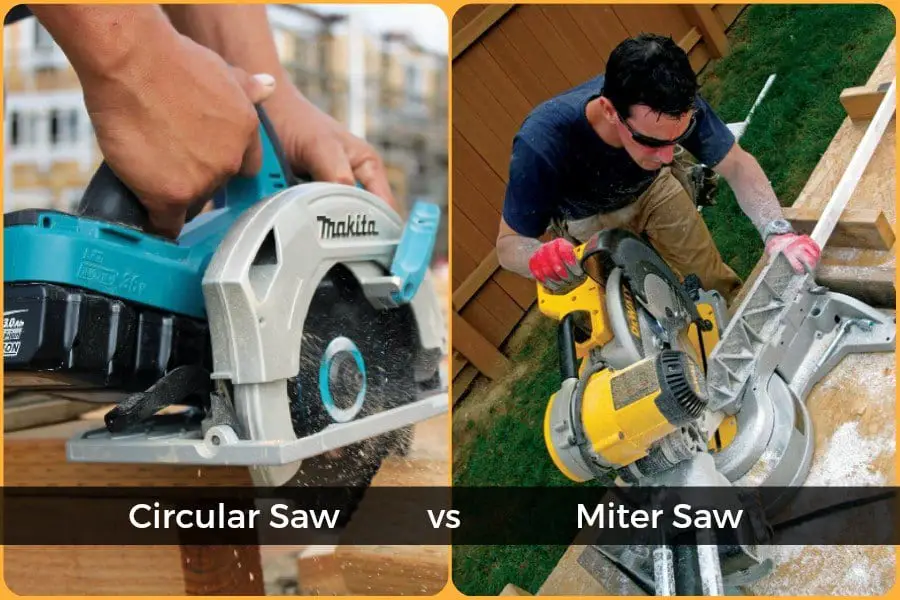The circular saw and the miter saw are two of the most popular tools in the DIY industry. And, there are multiple reasons that state why you need both of them.
Is this true?
Not necessarily.
In this short post, we’ll discuss the key difference between circular saws and miter saws.
Knowing the difference will help you make a more conscious buying decision, increase your skills through the frequent usage of the saw, and complete your projects faster.

Contents
Comparison Between Circular And Miter Saws
Versatility
Circular saws are more versatile than miter saws. If you’re a beginner woodworker and don’t know which one to choose, a circular saw is a good start.
In fact, the circular saw will be the most saw for your standard projects and woodworking.
While miter saws are suitable for squaring edges on board and cutting miters, they’re known as luxury tools. You don’t need them to operate in your workshop fully, but they are a great tool to have for specific occasions.
A circular saw an essential tool for any woodworking shop, garage, DIY, and professionals within the woodworking industry.
Cost
Circular saws are versatile tools that can cut virtually anything. On the other hand, miter saws are only useful for specialized cutting. For more detailed prices check our circular saws buyer’s guide.
Miter saws are 3x more expensive and should only be used once you’ve gained skill in using your circular saw. For more detailed prices check our miter saws buyer’s guide.
Sizes
Circular saws come in multiple blade shapes and sizes. On average, you’ll find them sized at 7¼ inches. Miter saws have larger blade sizes usually ranging from 7-10 inches.
When choosing a size, you’ll have to pick it based on the size and depth of your project. For small-scale tasks, you’ll want to get a blade that’s 7 inches.
But, if you’re planning on cutting through hardwood, then you’re going to have to get one that’s 10 inches.
What Are Circular Saws Used For?
Circular saws are a power saw that uses an abrasive disc blade or a toothed blade to cut through materials.
They can be used to cut through multitudes of material such as metal, plastic, masonry, and wood. They can either be handheld or mounted on a machine.
Circular saws are either right or left-handed. The blades are made of tungsten carbide tipped (TCT) for precision and longevity. Alternatively, high-speed steel (HSS) blades. Blade diameters range from 6 inches to 24 inches.
They are portable and fits blades that are 8, 10, or 12 inches which demonstrate the depth of the cut. There are other blades available and the more teeth a blade has, the finer the cut.
Blades come in multiple designs depending on whatever material is needed (cross-cutting, plywood, multipurpose, ripping).
What Are Miter Saws Used For?
Miter saws are used for accurate, quick angle cutting (45 angles for your picture frames). Also, they are great for cutting small pieces such as baseboards and molding. If you have the extra income, we suggest having one for your shop.
Additionally, they are used to create cross cuts. A crosscut is a cut that’s against the grain and its parallel to the board’s longest edge.
The only thing that limits miter saws is that its blade only moves up and down. Plus, they can only cut through materials up to 6” wide. They are unable to cut boards through their width.
Sliding miter saws are available and provide more versatility. While they can cut through 11” to 13” through wood, you’re still unable to cut through tougher materials such as plywood.
Mainly, miter saws should be used for specialized scenarios such as fine cutting, coarse cutting, and shape cutting.
Which One Is Safer To Use?
The risk is almost expected to occur when using a saw incorrectly. You have to take the proper security measures when working with the saw. Using circular saws requires more safety and a steady hand than other types of saws.
Circular saws operate with the blade’s circular motion. This means that if you wear loose clothes, you’ll increase your chance of injury and accidentally slicing your hand.
We suggest that you practice using your saws safely before using it for intense projects.
Why Do You Need Both Types?
As we stated earlier, having a circular saw is perfect for your first purchase. But, you need to have both a circular and miter saw to reduce the time it takes to finish your projects.
Both saws have similarities in their cutting accuracy. For instance, both have shorter tooth blades used for coarse cutting. They also have multiple tooth blades that can be used for fine cutting and angle cutting.
Circular saws require you to place the material towards the saw and cut up thick wooden pieces up to 6”. They are more durable and can last for up to 3 years before needing repairs.
A miter saw is perfect for angle cutting. You’ll be able to position the saw blade’s angle up to 45º and cut through light pieces of wood. Use a miter saw if you have to create complex shapes on small wooden boards.
We recommend that you start with a circular saw and then buy a miter saw afterward. Doing this allows you to cut through all types of wood without having to waste time replacing your blades.
Closing Remarks
Let’s face it; you’re going to need a high quality saw in your workplace if you plan on getting projects done on time. Reexamine your project guidelines to find out which saw is more useful for the occasion.
For your first purchase, a circular saw is the best option. But, if you to create angles on smaller wooden boards, then grab the miter saw. No matter which one you buy, both are a great addition to your garage.
Do you have any experiences using any of the saws?
Leave a comment below.


Thanks for guiding us to knowing how to get best woodcutting saw for my new business.
Thank you very much for this post. I recently got into woodworking and was buying some tools for home workshops to work on various projects. but as I am new to this and just starting out I don’t wanna spend too much money right off the bat. So I was looking for some tools that are absolutely necessary. That’s why I wanted to know whats the differences between these two saw. I think I’ll stick with circular saw as for now.
Thank you, great post, informative.
I was a little bit confused about which one to choose for my project.
Thanks for this informative article. Helped a lot!